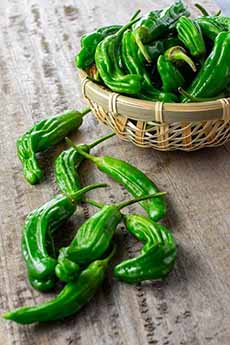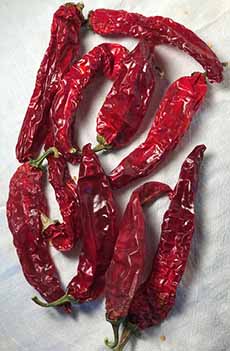Hatch Pepper Gift: A Cookbook & Gift Box Of Hatch Chile Foods
|
|
Hatch chiles from New Mexico are one of the most prized chiles of the southwestern U.S. There are both mild and hot varieties of these meaty fleshed chiles. The chiles are named after their original growing area of Hatch, New Mexico in the Mesilla Valley, just north of Las Cruces. The valley, which stretches along the Rio Grande’s southernmost bend before crossing into Texas and Mexico, is covered with row after row of green, leafy Hatch chile plants for most of the summer. Chefs say that the intense sunlight, hot days and cool nights in the valley result in a uniquely flavored chile. The harvest season is August through early September, but depending on weather conditions, the harvest can begin as early as July and finish in early October. Every September, after the harvest, there are Hatch chile festivals. In towns throughout New Mexico, the aroma of roasted chiles fills the air, along with the sounds of the Hatch chiles popping and crackling as they roast in propane-powered roasters. Here’s how to roast Hatch chiles over an open flame on a grill or a gas stove, or under the broiler. The difference between red and green versions is that green chiles (photo #1) are left on the vine longer until they turn red (photo #2). Green chiles have a brighter, zestier flavor while red chiles have a deeper, richer flavor. (It’s the same with bell peppers, which are members are the same family (Solanaceae) and genus (Capsicum). Heat lovers note: Unlike fresh chile peppers, dried chiles do not lose heat, taste, flavor or aroma when cooked. > Check out the different types of chiles. You don’t have to head to New Mexico for a Hatch chile festival. Have one at home, with this bounty of Hatch products from Melissa’s (photo #3). The Hatch-at-Home box heats things with everything you need for a Hatch food adventure. Discover more wonderful fruits and vegetables at Melissas.com. Discover delicious ways to use Hatch chiles in chile, chicken recipes, dips, sandwiches, sauces, soups, stews, Southwestern and Tex-Mex cuisine (photo #4). Try delicious and fun recipes like Sweet, Smoky & Spicy Party Nuts, Sweet Potato Bread with Hatch Pepper Compound Butter, Lobster Mac & Cheese with Hatch Peppers, Grilled Surf & Turf with Kale Sprout Slaw, and Hatch Pepper Pecan & Vanilla Bean Ice Cream (how can you resist the latter?). You can purchase the hardbound cookbook, or download a PDF. Melissa’s recommends a Viognier(vee-own-YAY) with Hatch recipes. The white wine grape, best-known in France, is planted in California, Oregon, Texas, Virginia and Washington (see the *footnote for details). Viognier’s floral aromatics and notes of juicy stone fruits pair perfectly with the kick of Hatch spice. You can also uncork a Chardonnay, Riesling or Sauvignon Blanc. And that’s your own Hatch chile festival! |
|
|
WHAT’S THE DIFFERENCE BETWEEN CHILES & PEPPERS OR CHILE PEPPERS? The original name, chile, comes from the Aztec language of the New World (chilli). When Columbus’ crew first tasted chiles, in the Caribbean, the heat and pungency reminded them of black pepper. They referred to the chiles as peppers or chile peppers. But black pepper is a completely unrelated genus; the fruits (yes, chiles are fruits) should be called chiles (the Spanish transcription) or chilies. But after 500 years, it’s tough to change the record. ________________ *On the nose, Viognier wines can also be very herbal, with aromas of chamomile, lavender, thyme and even a hint of pine. In aged examples and sweeter styles, this potentially overpowering herbal profile is softened by honeyed notes. The variety is not well known because it is difficult to cultivate; it is extremely prone to powdery mildew and is known for both low and unpredictable yields. Viognier is cultivated in Argentina, Australia, Chile, France, Italy, Japan, New Zealand, South Africa, Spain, Switzerland the U.S. [source]. The origin of the Viognier grape is unknown, possibly originating in Dalmatia (present-day Croatia) and then brought to France’s Rhône Valley by the Romans [source]. |
||






